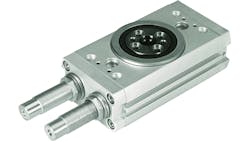Pneumatic Twin-Piston Semi-Rotary Drive
DRRD twin-piston pneumatic rotary actuators use rack-and-pinion assembly for high torque and rotational speed in a compact package. Ideal for material handling and assembly operations, it offers a high load capacity with torque from 0.2 to 112 Nm and a maximum mass moment of inertia of up to 420,000 kgcm2. These features allow smaller sizes of this semi-rotary drive to be used without sacrificing power, saving money and space in handling and assembly technology or in machine building. Standard rotational output is 180° but is adjustable from 0 to 200°.
Size 16 and above in the DRRD series has the option of an end-position lock for mechanical locking in the end of mid-position. Other options in the series include: a fully sealed variant for wet or dusty environments; an external position sensing version with sensor mounting; an intermediate positional model; one external and two internal cushioning model; and, an energy through-feed model that allows for fast and easy supply of electrical signals or compressed air transfered via a hollow shaft.
Festo Corp., (866) 463-3786

